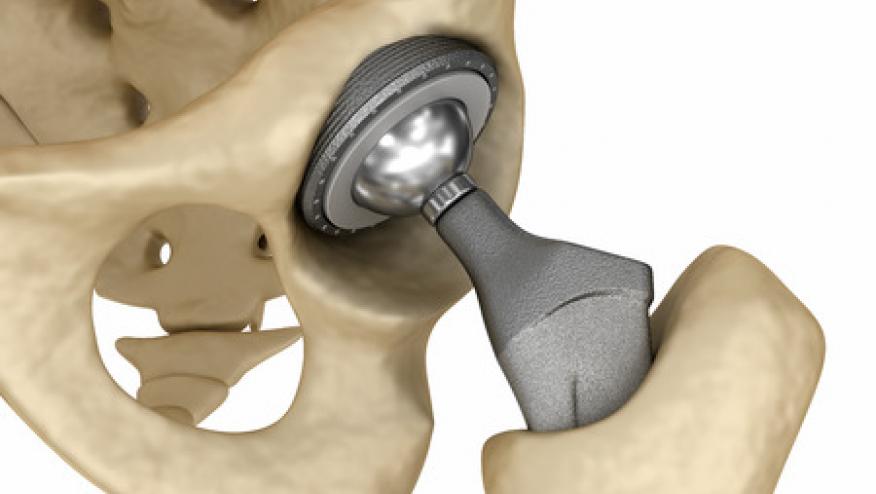Joint Implant Metals May Be Leaking Save

Key Takeaways
- Most arthroplasty implants include metallic components including known neurotoxic elements such as cobalt and titanium.
- Release of metal molecules from implanted devices has long been a concern, most notably for metal-on-metal hip replacements.
- This study showed increased metal concentrations in cerebrospinal fluid, but it did not address whether there were adverse clinical effects.
Patients with metal-containing joint replacements had significantly higher concentrations of cobalt in their cerebrospinal fluid (CSF) relative to patients without arthroplasties, researchers reported.
Although CSF in both groups carried this and other metals, the increase in cobalt levels may be of clinical importance, according to Anastasia Rakow, MD, of Charité-Universitätsmedizin Berlin in Germany, and colleagues in the 204-person study.
"In view of the known neurotoxic potential of especially cobalt, but also of titanium and niobium," the group wrote in JAMA Network Open, it will be important to determine whether these increased levels "correlate with objective measures of neurotoxic effects."
As well, they added, such studies "may be particularly relevant in patients with new-onset or deterioration of preexisting neurological or psychiatric disorders following arthroplasty, and in general, in manufacturing orthopedic implants of the future."
Shedding of metal molecules from medical devices has long been a concern, most prominently for so-called metal-on-metal hip implants. As Rakow and colleagues explained, metal leakage has been shown "to negatively impact bone and soft tissues surrounding" implanted devices. Worries about systemic effects have more recently been growing, with "case reports and series link[ing] systemic arthroprosthetic cobalt exposure to significant cardiac, thyroid, and/or neurological dysfunction," for example.
Cobalt is particularly toxic, but other metals commonly used in arthroplasty devices -- titanium, niobium, chromium, aluminum, and others -- may also be damaging to neural tissues. While metal levels in blood and serum are known to be increased in people with implanted devices, the extent to which they may cross the blood-brain barrier, and what adverse effects may result, are less well understood. "Studies on structural changes in the brain as a function of bloodstream exposure to cobalt and chromium released from arthroplasty implants show contradictory results," Rakow's group observed.
The researchers obtained whole blood, serum, and CSF samples from 102 arthroplasty patients and the same number of age- and sex-matched patients without such implants. For those with arthroplasties, the median time since implant was just under 10 years. Mean current age was 72 for arthroplasty patients and 67 for controls, and 58% of both groups were women. One-third of the implant group had more than one device. Almost exactly half the group had knee replacement, 49% had hip implants, and the rest had shoulder arthroplasties.
Median levels of certain metals in whole blood were as follows for arthroplasty patients versus controls (all μg/L):
- Cobalt: 0.27 patients, 0.16 controls
- Chromium: o.47 patients, 0.42 controls
- Titanium: 8.05 patients, 7.15 controls
- Niobium: 0.02 patients, 0.01 controls
- Zirconium: 0.05 patients, 0.03 controls
In CSF, however, only cobalt appeared to be significantly more plentiful among arthroplasty patients than in controls (median 0.03 vs 0.02 μg/L), the researchers indicated.
More detailed analyses, however, suggested that other metals could also be a concern. For example, patients with at least one cobalt-chromium-molybdenum device showed significantly higher CSF levels of both cobalt and chromium than did controls.
Another finding suggested that excessive wear or device failure might be responsible for increased CSF cobalt: participants reporting pain in the implanted joint had higher cobalt levels relative to controls. "This significant difference was not observed in patients with a pain-free index joint," Rakow and colleagues noted.
One limitation to the study was that more than one-third of both implant patients and controls also had non-arthroplasty metallic implants such as dentures and cardiovascular stents and pacemakers; some 15% had metal piercings as well, and about 6% reported occupational exposures. These sources may account for the detectable metal levels in controls' fluids, potentially confounding the results. Also, the arthroplasty group was older on average than controls, and the cross-sectional study design precluded any tracking of patients over time.
Source Reference: Rakow A, et al "Metal concentrations in blood and cerebrospinal fluid of patients with arthroplasty implants" JAMA Netw Open 2025; DOI: 10.1001/jamanetworkopen.2025.2281.










If you are a health practitioner, you may Login/Register to comment.
Due to the nature of these comment forums, only health practitioners are allowed to comment at this time.